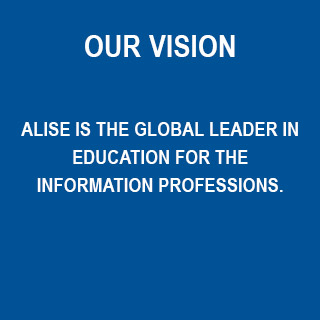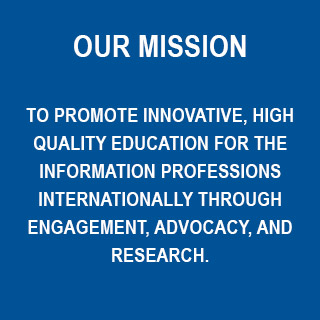ALISE: History and Strategic Direction
Vision and Mission
 
Strategic Directions
In an era of rapid change, the Association for Library and Information Science Education (ALISE) remains steadfast in its commitment to serve as the international leader in both education practice and research for established and emerging career opportunities in the information professions. To remain relevant and a vital part of the information professions, the 2021-2025 ALISE Strategic Plan has been crafted to address four strategic directions to meet the needs of existing and future members and the information professions as a whole.
Strategic Direction 1: ALISE promotes innovative pedagogy, teaching, and creative content delivery, informed by evidence-based research.
-
Objective 1.1: Demonstrate pedagogical and teaching leadership through innovative and relevant programs, webinars, and videos.
- Strategy 1.1.1: Highlight one or more innovative pedagogical and/or teaching programs, webinar, video, or other content per quarter on ALISE marketing platforms (website, social media, Quarterly Updates) by FY22.
-
Objective 1.2: Encourage and support pedagogical and teaching advances informed by evidence-based research that meet the varied interests and needs of members around the world and at different degree levels in library and information science (LIS) and allied disciplines.
- Strategy 1.2.1: Update the teaching interest categories on the membership form by FY21 Q2.
- Strategy 1.2.2: Increase the number of speakers from allied disciplines for webinars and conference events by 10% by FY24 Q1.
- Strategy 1.2.3: Assess the needs of other LIS and allied discipline organizations worldwide on pedagogical and teaching issues and identify collaboration opportunities by FY24.
- Strategy 1.2.4: Organize and compile resources on curriculum or programmatic activities pertaining to equity, diversity, and inclusion by FY23 Q2.
Strategic Direction 2: ALISE expands its membership base, enhances membership value to both individuals and institutions, and enriches member engagement.
-
Objective 2.1: Evaluate and enhance individual and institutional membership benefits.
- Strategy 2.1.1: Review and identify changes to membership benefits as appropriate by FY21 Q4.
- Strategy 2.1.2: Re-institute the ALISE Statistical Report Executive Summary to accompany the raw data as an institutional member benefit.
-
Objective 2.2: Develop and implement a membership growth plan that retains and engages current members, attracts new members in a broader range of disciplines and who are earlier in their careers, and re-engages lapsed members.
- Strategy 2.2.1: Increase membership from institutional and personal members by 2% annually through the development of a plan to approach lapsed members about rejoining.
- Strategy 2.2.2: Increase new institutional and personal member count by 2% annually through the development of a recruitment plan.
- Strategy 2.2.3: Increase personal member count by offering one-year memberships to non-members registering for the annual conference.
- Strategy 2.2.4: Establish retention rate baseline for institutional and personal memberships by FY21 Q2.
- Strategy 2.2.5: Develop a membership onboarding plan, schedule, and collateral for new members through their first year by FY21 Q2.
- Make new members feel welcome in the association through social media shoutouts and spotlights in the Quarterly Update by FY21.
- Strategy 2.2.6: Increase international member count by 2% annually by promoting virtual engagement opportunities and other benefits.
- Strategy 2.2.7: Attract members from a broader range of disciplines, such as by partnering with other associations, co-producing a webinar with another association for the respective discipline, inviting other disciplines to submit conference proposals, incorporating interdisciplinary articles in JELIS, and marketing ALISE events and publications to other disciplines.
-
Objective 2.3: Provide relevant and timely support to members across the span of their careers including both full-time and part-time faculty.
- Strategy 2.3.1: Conduct a member needs assessment study based on the stage of their career including both full-time and part-time faculty by FY21 Q4 and report the findings back to the members.
- Strategy 2.3.2: Develop a plan to address member needs across the span of their careers including both full-time and part-time faculty based on the assessment by FY22 Q2.
- Strategy 2.3.3: Expand webinars, workshops and other programming on topics of current and enduring interest across the span of members’ careers including both full-time and part-time faculty.
- Strategy 2.3.4: Provide at least one leadership development program (e.g., Academy, webinar, panel sessions) annually to nurture the next generation of leaders for programs in LIS and allied disciplines.
-
Objective 2.4: Promote SIGs to members, expand engagement in SIGs, and enhance the visibility of the work that SIGs do and relevance to members.
- Strategy 2.4.1: Review SIG focus areas to ensure SIGs are meeting ALISE member interests, identify opportunities for new or refocused SIGs, and sunset inactive or non-primary SIGs.
- Review SIGs against minimum requirements on an annual basis; recommend SIGs for removal that do not meet minimum requirements.
- Strategy 2.4.2: Develop a plan to increase SIG membership and participation by FY21 Q3.
- Strategy 2.4.3: Revise and/or create resources (e.g. website, PPM) for SIG conveners to streamline the process and engage SIG conveners and members by FY21 Q3.
- Strategy 2.4.4: Conduct an annual training webinar for SIG conveners beginning in FY21.
-
Objective 2.5: Make ALISE welcoming and inclusive of people and programs from countries outside of the U.S. and Canada.
- Strategy 2.5.1: Engage key representatives from outside North America on a task force to guide ALISE on strategies for making ALISE more inclusive by FY22 Q1.
- Strategy 2.5.2: Encourage and promote topics and discussions related to education and pedagogical practices outside North America by FY22 Q4.
-
Objective 2.6: Increase participation from and provide better support to people of color, under-represented groups across equity, diversity, and inclusion lines.
-
Strategy 2.6.1: Intentionally recruit people of color to join ALISE, serve on ALISE committees, Conference organizing committees, etc.
-
Strategy 2.6.2: Establish a task force to advise ALISE on strategies for increasing our “diversity” footprint by FY21 Q1.
Strategic Direction 3: ALISE builds collaborations and partnerships to advocate on educational issues on behalf of members and to advance public knowledge of the information professions.
-
Objective 3.1: Continue to develop collaborative opportunities with affiliate organizations such as with the iFederation (a partnership between ALISE, ASIS&T, and iSchools) and other related associations.
- Strategy 3.1.1: Offer joint programming or co-sponsored conference, public presentations, webinars, or other content at least once per year by FY21.
- Strategy 3.1.2: Evaluate the outcome of collocating and holding the 2022 ALISE and ASIS&T Conferences back-to-back by FY23.
- Strategy 3.1.3: Work with iFederation on preparing association members to be effective advocates for the information professions and quality of information education.
-
Objective 3.2: Advocate for the interests of LIS educational institutions in accreditation.
- Strategy 3.2.1: Consult regularly with ALISE’s representatives to ALA Committee on Accreditation and Committee on Education by FY21.
- Strategy 3.2.2: Provide an annual report to the ALA Office of Accreditation on issues and concerns related to accreditation in general and accreditation standards by FY22.
Strategic Direction 4: ALISE embraces innovative, strategic and effective association management practices.
-
Objective 4.1: Enhance profitability and predictability of revenue streams to ensure operations are sustainable and support the needs of the organization.
- Strategy 4.1.1: Approve annual operating budget with positive net income annually.
- Strategy 4.1.2: Contribute 5% of annual income (when positive) to a savings and/or investment fund (e.g. money market fund).
- Strategy 4.1.3: Develop a fundraising plan for ALISE Endowment Fund with the goal of increasing donations by 10% by 2025.
- Strategy 4.1.4: Evaluate opportunities to develop an annual sponsorship program.
- Strategy 4.1.5: Develop a comprehensive sponsorship prospectus for both the annual conference and awards; begin selling at the current year’s annual conference for the next year.
-
Objective 4.2: Deliver content and events throughout the year.
- Strategy 4.2.1: Deliver year-round webinars annually beginning in FY21.
- Strategy 4.2.2: Develop fee-based on-demand products for non-members from the webinar recordings by FY21 Q2.
- Strategy 4.2.3: Host a wider variety of virtual events, such as meetups and speed networking, on a quarterly basis beginning in FY21.
- Strategy 4.2.4: Deliver more extensive content and series events that promote EDI within LIS pedagogy, research, and teaching beginning in FY21.
-
Objective 4.3: Enhance the value and usability of the ALISE Statistical Report.
- Strategy 4.3.1: Publish an executive summary report to accompany the release of the ALISE Statistical Report (data) beginning in 2021 (2020-2021 academic year data).
- Strategy 4.3.2: Produce a webinar annually, beginning in 2021, reviewing the latest ALISE Statistical Report and executive summary.
-
Objective 4.4: Ensure the governance structure of ALISE continues to operate in a strategic and effective manner and is well-positioned to lead the association and execute the strategic plan.
- Strategy 4.4.1: Review roles and responsibilities of each Board position annually and redefine positions based on the Association’s current and future needs.
- Strategy 4.4.2: Ensure the Board of Directors continues to lead and guide the association to embody equitable, diverse, and inclusive practices.
Model for ALISE Strategic Plan:
- Level 1. Strategic Directions: What do we want to achieve?
- Level 2. Objectives: Where will we focus our efforts?
- Level 3. Strategies: How will we achieve outcomes and measure performance?
Past Strategic Plans:
History
The Association now known as the Association for Library and Information Science Education (ALISE) was founded as the Association of American Library Schools. The original association grew out of a series of informal meetings of library school faculty at American Library Association conferences which were known as the Round Table of Library School Instructors. The Round Table voted in 1915 to form a permanent organization and to be identified as the Association of American Library Schools. The Association has provided a forum for library educators to share ideas, to discuss issues, and to seek solutions to common problems. In 1983, the Association changed its name to its present form to reflect more accurately the mission, goals, and membership of the Association.
ALISE Archives
The ALISE archives are housed at the University of Illinois at Urbana-Champaign.
Archives
ALISE Past Presidents
Former Presidents
|